Reading sample:
GTS is a compliance tool. For this reason, our practical guide offers not only software assistance, but also compliance assistance. We trust that the material will assist you as you develop and/or review your own company’s compliance programs.
We also offer suggestions on how to audit the effectiveness of your GTS installation—ensuring you can withstand any external audit should it ever occur.
Practical Guide to SAP GTS Part 1: SPL Screening and Compliance Management
Book 1 focusses on compliance management, with an in depth review of sanctioned party list (SPL) screening. Book 2 covers customs management and preference processing. It is our hope that the multi- book format will allow you to choose the topics that you need the most.
Sanctioned party list screening
One of the most commonly used functions in SAP GTS is sanctioned party list screening, or SPL checking. SPL checking means that all of your business partners and documents will be checked against known lists of sanctioned or restricted parties.
Introduction
Everyone understands what a country embargo is; in other words, you may not deal with that country. For example, US companies cannot do business with North Korean companies. However, it is not as well known that government agencies more often embargo individuals and entities than they do countries. For example, the US Department of the Treasury lists entities in certain countries, such as Libya, that it considers a danger to the national interests of the United States. As a result, a US company may not sell to any of the listed companies or individuals. The lists of forbidden or restricted parties are called Sanctioned Party Lists, or SPL.
SPL lists are commonly thought of an “export” issue, and most companies understand they must ensure they never export to a listed entity. However, these lists can apply to imports as well as domestic activity. Buying from or selling to a person in your own country could violate certain SPL rules; for example, there are US entities on many of the lists.
In the next section, we will review the suggested settings, best practices, and user tips for SAP GTS SPL functionality. It is not intended to be exhaustive but rather covers the most commonly used areas of the software, as well as those most likely to cause confusion.
Before we begin, we would like to explain the way SAP GTS SPL works on a high level. To illustrate, we will look at three simple process flows, including:
- How an SPL match is determined.
- How a business partner block is determined and managed.
- How a document block is determined and managed.
Figure 1.1, Figure 1.2, and Figure 1.3 display these processes in the form of a flow chart. These simple flows are not meant to capture all SAP GTS functionality but rather to provide a high-level overview of its three core competencies: determining a match, blocking a partner that matches, and blocking a document containing a matched partner.
For example, there are many more settings available to fine-tune the match logic than what is shown. By reviewing this diagram, you will better be able to understand where the other features fit in and how they affect the outcome of checks.
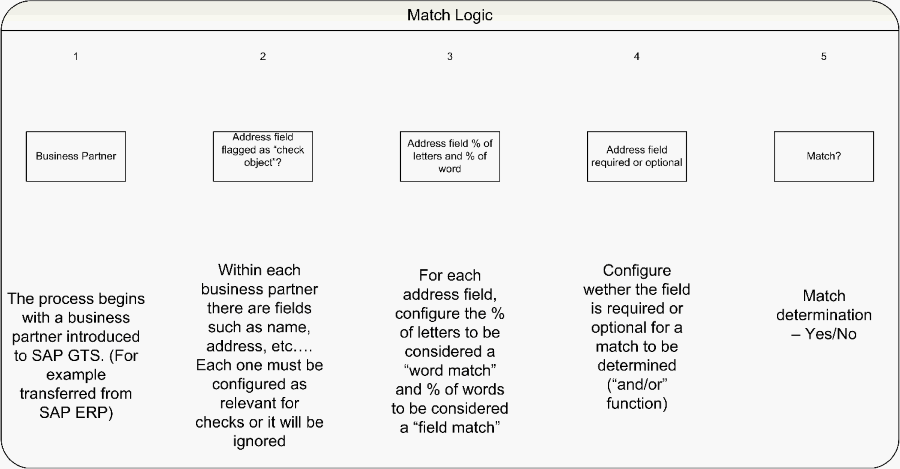
Configuration
SPL screening involves screening your business partner (BP) against lists of SPL uploaded to SAP GTS as XML files. Third party companies provide this content as a service and send you updates when the government updates the list. SPL involves screening text or characters, which is very performance intensive. To address this, SAP GTS allows you to build an index of denied party list (SPL) content. Business partners use this index to improve screening performance.
The indexing function is addressed in SAP GTS master data (see Section 1.7.3). Indexing is important. As the system runs sanctioned party list screening, it breaks down the SPL master data and business partner data into search terms and only compares the generated search terms during screening. This reduces the runtime of sanctioned party list screening significantly.
SAP GTS provides you with many options and flexibility for SPL Screening. It can adjust to match the business needs of any organization based on its risk exposure and business activity. This sort of flexibility is available through multiple settings from which each installation can choose. There are two key areas of configuration that determine these settings: (a) control settings, which influence the way SPL functionality functions, and (b) control procedures, which allow you to set certain rules within user control, such as exclusion, alias, etc.
Subscription service
We highly recommended that you subscribe to a data provider for your SPL lists. The lists are not static and can have additions or deletions on a daily basis. Considering the many lists in play and the fact that each can change on any given day, it is essential that you receive these lists from a third party.
There are three key decisions you must make regarding your subscription:
1. Choose a data provider. 2. Select specific subscription lists from those available. 3. Maintain subscription lists
TREX
With SAP NetWeaver 7.0, SAP released SAP NetWeaver Search and Classification 7.0 (TREX) technology. SAP GTS 7.2 and higher can make use of the technology to search and compare addresses with sanctioned party list (SPL) screening. The screening can be very performance-intensive because it searches across names, addresses, and many characters within associated fields. TREX can help make this smoother and more efficient while improving your chances of finding a close match.
TREX also provides the enhanced ability to dissect words. Standard GTS SPL functionality requires “word within word” matching. For example, “Kevin” must be found in “Kevinski.” “Kevin” would not hit against “Kenvin” without TREX. TREX will allow for this kind of scrambled search, provided the total percent of letters matches. For this reason, TREX is considered a superior tool, and we recommend using it.
TREX provides the latest search technology available, which is adopted for catalog search and other features. This tool is an alternative to the main or core SPL search functionality. One of the advantages of using the TREX central engine is that you can exploit advanced features in future releases of TREX, such as TREX 7.1.
To implement TREX, you need to perform the following actions:
- Install TREX.
- If you’re using TREX 7.0, you need a 32-bit processor.
- If you’re using TREX 7.1, you need a 62-bit processor.
- Set up a Remote Function Call (RFC) connection between SAP GTS and TREX.
- Select required configuration settings in SAP GTS (see Section 1.2.2).
- Make a SAP GTS cockpit setting for the TREX RFC connection setup.
- Address operational considerations, such as transferring the TREX search index for SPL screening and using the central SAP NetWeaver search engine.
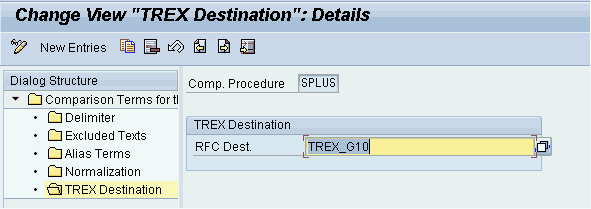
Email alerts
When you configure SAP GTS, you can set it so that users are warned when they create a partner or document that is blocked. Typically, the primary SAP ECC system (we will assume ECC is used) will display a warning message to the SAP user as displayed in Figure 1.24.
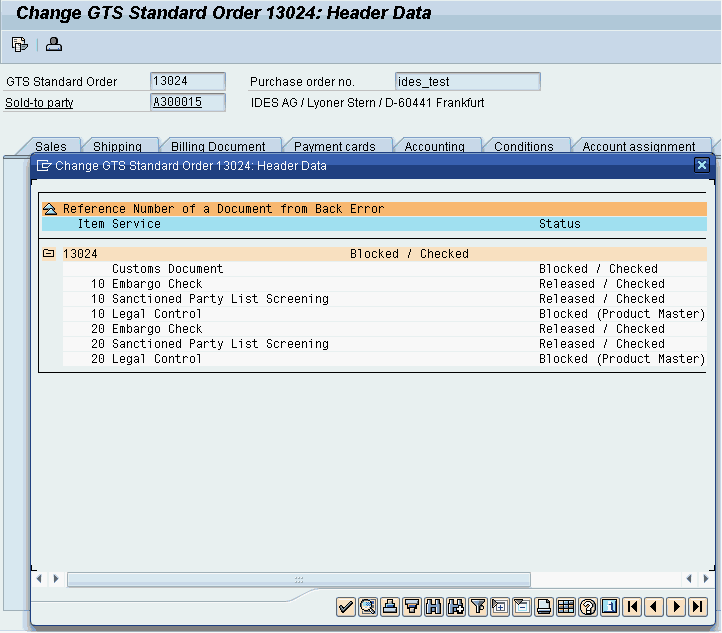
The example in Figure 1.24 is the warning message that appears when a customer service agent enters a new sales order and GTS finds a potential match resulting in a blocked document.
SAP GTS also has the functionality to email users when it blocks a document or a business partner. This is important because the user who caused the block (e.g., by entering the order) is usually not the same user who will review/release the block. You will want these emails to go directly to the individual or group responsible for review/release of GTS blocks. See Section 1.2.1 for setup instructions.
Logistics – daily execution
The SPL functions in the Logistics – Daily Execution section are all accessed through the following screens. First, in the GTS main menu, select the GTS Area Menu using transaction /SAPSLL/MENU_LEGAL (see Figure 1.25). From there, you will be in what is called the Global Trade Services “Cockpit”.
Master data
Maintain sanctioned party lists
Assuming you have gone with the recommended approach of using a subscription service for your SPL lists, this screen will really only be used for one purpose: to create and maintain a company-controlled SPL list.
The purpose of this list is to allow you to block partners that are not actually listed on any published SPL lists. Your company can have many reasons to use this function: a customer who failed to pay you, and you want to ensure they never get product again.
Perhaps a vendor engaged in unethical behavior, not serious enough to be listed as a government SPL, but serious enough for you to discontinue all business with them. Or perhaps, a true SPL entry from a list you chose not to subscribe to.
Display overview list
Display overview list is a way to review your populated SPL lists. This is a display only function, and as such, access to it can be shared with most users. The menu is shown in Figure 1.61. Some of the menu options are:
- Type of List: Search only certain lists if desired, such as a particular Department of the Treasury Specially Designated National List.
- Validity Dates: Narrow your search to only currently valid entries by limiting the validity date to the present and future.
- Changed/Created on: If, for example, this was a subscription data audit, this option would allow you to view only those SPL entries that were created or updated in a certain date range so that you are not reviewing any that have been previously audited.
Comparison terms
Comparison terms are the indexing function for GTS SPL searches. In theory, the searches can be run without these terms being up to date, but realistically, it will slow the system down and may even result in inaccurate searches. To ensure accurate and timely results, comparison terms must be run any time a change is made relevant to them. There are two general categories of terms, SPL and BP.
Control settings for comparison terms
General settings SPL master data requires you to set up the control settings for the configured search terms. You can do this using transaction /SAPSLL/MENU_LEGAL or following menu path SAP GRC GTS Area Menu • SAP • Compliance Management • Sanctioned Party List Screening • Master Data • Control Settings for Comparison Terms • General Settings
Cross-area monitoring
Analyze reasons for release
This is a very useful report for auditing. You can use it not only view the results of user decisions, as in an audit trail report, but also to capture the reason for release. This report is also a good way to review the users’ work and ensure they are in fact using a reason for release. The menu is shown in Figure 1.64; let’s look at some of the key options on this screen.
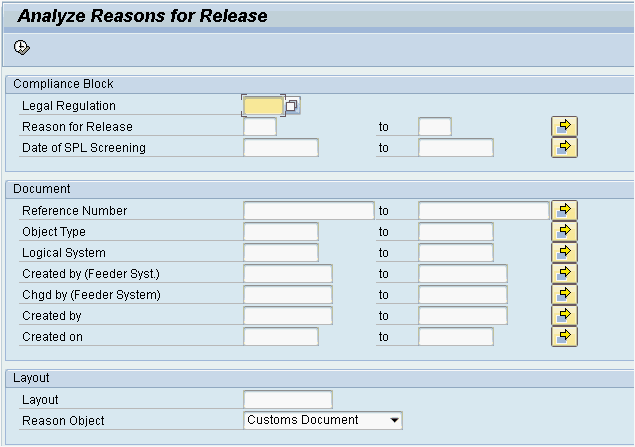
- Reason for Release: Use this option to only search releases done for a specific reason.
- Date of SPL Screening: This option narrows the search to the date of the SPL screening.
- Reference Number: This can refer to either a business partner number or a document number, depending on the choice you make in the Reason Object field described below.
- Reason Object: Use this field to specify either business partners or documents. Both options cannot be checked at the same time and must be audited separately.
Overview of SPL lists
In Appendix 2: Website resources, you will find a summary of various lists that are commonly checked against. As explained in Section 1.3.1, these list names and acronyms are taken from the data provided by MK Data Services. There are other sources of SPL data that may look different, but the information contained in the lists and the general structure of the lists should be largely similar.
These lists come from various sources but generally are created by a particular country’s government agency or agencies (e.g., the US Department of the Treasury). Some lists, however, come from non-government agencies such as the United Nations Security Council or the World Bank.
Compliance
Every business transaction that crosses a border, whether outbound or inbound, needs trade compliance checks. Compliance checks involve checking all the business partners that are in the shipping document against the sanctioned party list to make sure that the country being shipped to is not under embargo, as well as checking whether the product being shipped needs a license or license exception.
Import compliance checks overview
Compliance Management, a module in SAP GTS, allows you to support the monitoring of the transactions that are transferred to SAP GTS, such as embargo data maintenance, transaction review, release, and business partner review due to an embargo. All of this can be done from the legal control import screen (see Figure 2.1).
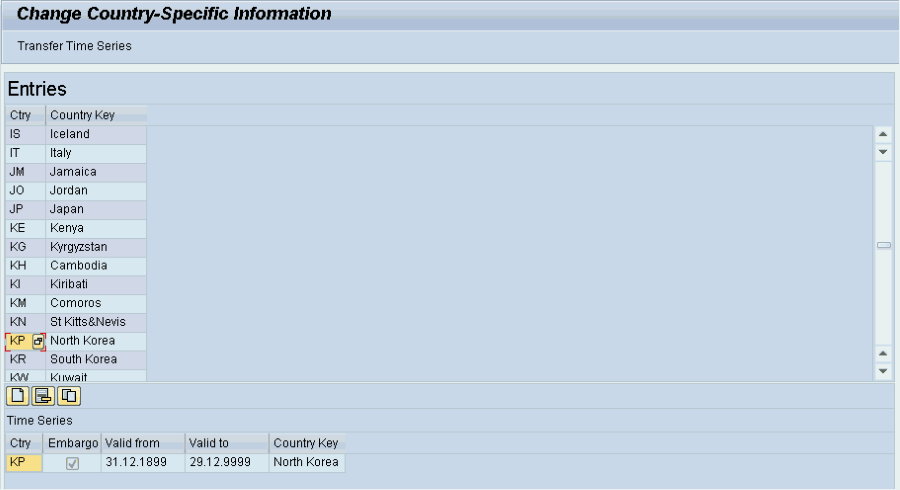
Export compliance checks overview
To support export compliance, SAP GTS offers the Legal Control – Export screen, which has similar functionality to the Legal Control – Import screen. You can get to this screen from SAP GTS Area Menu • Compliance Management • Legal Control-Export (see Figure 2.6).
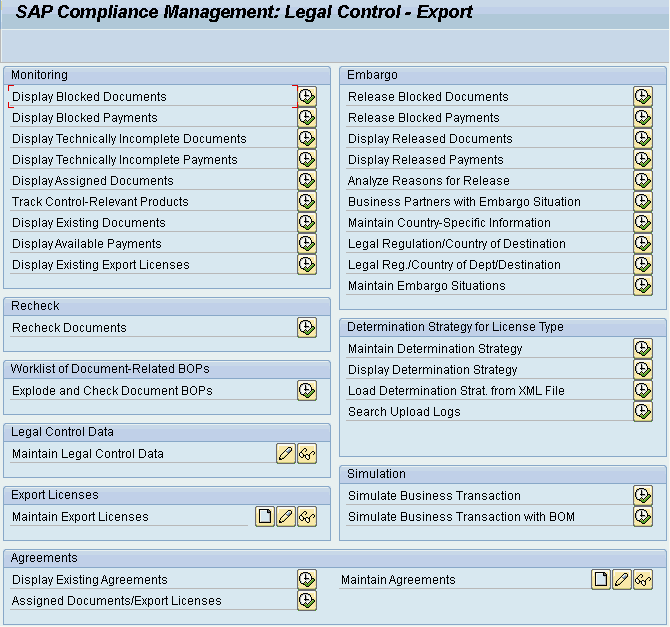
Legal control import/export
Legal control export/import allows you to enable the license determination for your outbound and inbound transactions (sales and purchasing). SAP GTS enhances the license determination functionality by allowing companies to meet complex license requirements. Many business rules and settings move to the SAP GTS cockpit for easy access and ongoing maintenance.
Embargo checking in SAP GTS
Embargo checking is performed when a business partner is created. Therefore, if you have a business partner created in ECC and transferred to SAP GTS, it will screen the business partner for an embargo. With business partner transfer, if screens the business partner against the embargo list maintained in GTS. If it finds a match, it blocks the customer for embargo.

Product classification
All goods shipped out of the US must be labeled with their five-character Export Control Classification Number (ECCN), license or license exception, and Schedule B or Harmonized Tariff Number. ECCN are associated with the product and describe the classification of the product in which category falls under or group and relevant control, or lack of it applies. Without a Schedule B, you cannot complete the Shipper’s Export Declaration (SED), and other export declaration documentation requires these three critical pieces of trade information: ECCN, Schedule B, and License or License exception, if applied.
Furthermore, you also need a Harmonized Tariff System number for import into any country around the world. You need to be able to access these numbers quickly and easily. The classification tool in the SAP GTS facilitates searching for the right number and allows you to classify and assign the classification number to a product.
License determination
License determination is among of the most important functionality in any global trade compliance solution. In any business transaction, be it purchase orders or sales orders, you are dealing with business partners (vendors, customers) and a product or service. The product or materials being shipped are given a number and description that is understood by your customer and vendor. For exports or imports, products are classified further so that the customs authorities understand them in the exporting and importing country.
Usually the exporting country imposes control over products based on the classifications. For example, certain products based on the classification might not be allowed to export to a certain country or customer due to its application and risk. Some products may be allowed, but only with the permission of the controlling agency in the form of a license.
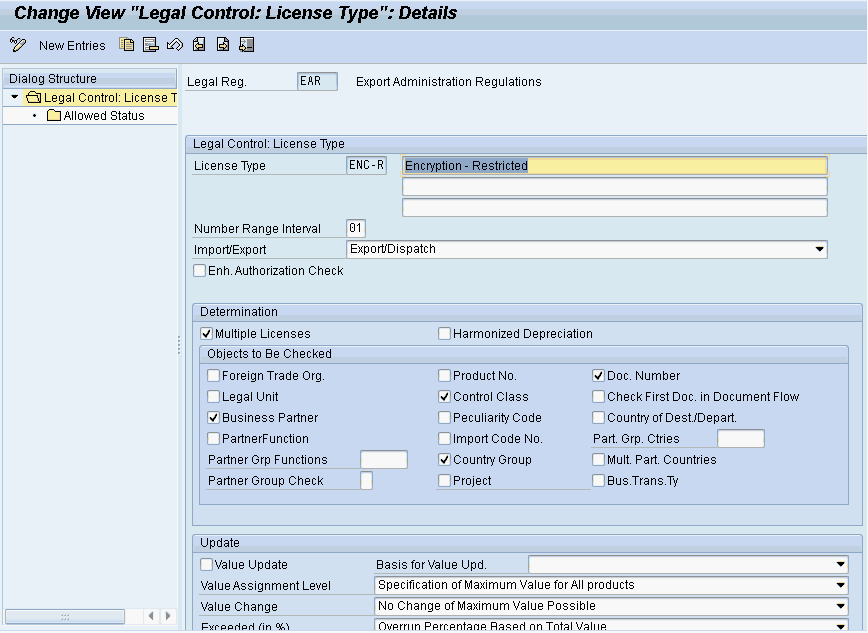
SAP GTS has enhanced this license type by adding more attributes and features (status, control settings, partner type checking, and customer-defined procedures for license type determination). More attributes allow you to define licenses with stricter control and accuracy. For example, before a license can be assigned, all of these attributes need to be satisfied. Use the Allowed Status functionality to maintain the status for a license, such as active or expired. Figure 2.20 displays the definitions available in the license types in SAP GTS.
ITAR
Imagine a defense equipment manufacturing company wants to bid on the design of an equipment or control system that can be used in a missile or fighter jet. Before it can even engage on the bid and share specific product information, the US State Department requires the exporter to apply for a technical assistance agreement (TAA) to facilitate the sharing of information. The TAA operates similarly to a license, and you can designate it for a specific product, USML, customer, country, and so on.
When an exporter wants to ship physical goods out of the country, the company needs to apply for an export license, such as a DSP-5 (Permanent Export). The application for this license must reference the existing and valid TAA associated with the project involved with this sale or shipment. The application of the DSP-5 must take into account the attribute on the TAA such as dates, values, quantities, and so on. Temporary export for public exhibition, trade show, air show, or related event, even if the physical goods were licensed previously for public exhibition, require a DSP-73 (temporary export).
For situations such as these, you can use the agreements and license type functionality features in SAP GTS Compliance Legal Control. We will show you the configuration steps to meet the ITAR requirement with license types referencing agreements and how they are managed in the system. We will look at the example at a defense manufacturing company and see how the agreements are used for initial export shipments and then referred within the license type for subsequent shipments.
EH&S
Environment, Health, and Safety (EH&S) are guidelines or federal regulations in different areas, including environmental, occupational health and safety, community health and safety, and construction and decommissioning. EH&S in SAP ECC comprises of several components, such as basic data and tools, product safety, hazardous substance, dangerous goods management, waste management, occupational health, and industrial hygiene and safety.
Examples of daily user functions in compliance
This section reviews several common daily user functions in the GTS compliance area. This list is not meant to be a comprehensive review of all available functions; rather, these activities have been identified as commonly used and illustrate how to use the system.
Compliance management tips
Trade compliance managers had busy years in 2014 and 2015. That was when the US Government announced and implemented changes to their export and import controls, including but not limited to:
- Export Control Reform – moving items subject to the ITAR rules out of ITAR and into the EAR (Export Administration Regulations)
- Changes to the rules regarding trade with Cuba
- Increased sanctions against countries such as North Korea and Russia
- Near-daily updates to the OFAC and BIS Sanctioned Party Lists during the Ukraine crisis
Furthermore, UN and multinational efforts such as the Wassenaar Arrangement and Australia Group announced changes to their controlled products lists. This triggered changes to the export regulations in member countries.
SAP GTS Release 11.0
SAP released version 11.0 of GTS in early 2015, which is the latest version as of the writing of this book. SAP GTS 11.0 brings with it several key changes and enhancements, which we will summarize in this chapter. One of the key changes that 11.0 brings is compatibility with SAP HANA. SAP HANA is redefining database speed and capability in the SAP world with in-memory processing.
General configuration settings
There are some new selections and choices available in configuration to support new functionality. Let’s review some of the new options and discuss their purpose and benefits. The features discussed in Section 3.1 are all found in the General Settings portion of configuration.
After starting the relevant report program in the SAP area menu, the data is immediately available for analysis and further processing. The following SAP GTS Accelerators are available:
- GTS Accelerator for audit trail
- GTS Accelerator for blocked business partners
- GTS Accelerator for blocked documents
When you first enter the configuration screen, click on New Entries to bring up the image in Figure 3.1.
In-memory optimization
One of SAP HANA’s key benefits is its in-memory functionality and the increased performance that it brings. In-memory means that the computer processor performs the database functionalities within its main memory, as opposed to accessing a disk storage system.
SPL with HANA Search
As discussed already, SAP HANA is a significant new feature for SAP GTS with 11.0. No function is more affected than SPL. With 11.0 and HANA, there are three noticeable improvements to SPL.
Enhanced user experience
Next to HANA, perhaps the most exciting recent development in the SAP realm has been Fiori. According to SAP, “SAP Fiori is the new user experience (UX) for SAP software that applies modern design principles.”4 To put this in plain English, SAP Fiori brings the pleasant visuals and easily navigated interfaces that users have come to expect from other technology such as their smart phones. In other words, it is easy and quick to use.
Appendix 1: SPL list types and references
The table below lists common lists that businesses screen against. The list codes are from MK Data Services and are used with permission. Next to each list code is a description explaining what the list is, in addition to a website where the user can go for further information.
This is meant to be a tool that you can incorporate into your company’s SPL compliance program. When you have a potential match against one of these lists, you can go to the website to better understand:
- If you have a true match, and
- What the significance of the list is.
This table is not a complete list of SPL offerings. It is intended to show the most common and most important lists, and to assist you as you customize your own internal training program. Since lists change frequently (some are delisted and new ones are created) this is not meant to be a static tool—you must review it and keep it updated constantly. It is our hope that this will give you the start of a good tool and point you in the right direction.
Appendix 2: Website resources
The following lists of websites are publicly available sites, where you can research various relevant topics. They are sorted by key categories. This list will be useful as you perform your master data set up and classifications. It will also lead you to sites that further explain various concepts discussed in this book.
Tags
- compliance
- gts
- management
- screening
- sql
Sign up for the newsletter and never miss any more news!
As a thank you, you will receive a 10% discount on a one-year license for our SAP learning platform.1
* Required
1. One-off and only for new customers. The voucher cannot be combined with other promotions and can only be redeemed at Espresso Tutorials GmbH.